SF fans of a certain age may have read Jerry Pournelle’s fascinating 1975 essay “The Big Rain,” which assured readers that
Not only can we terraform Venus, but we could probably get the job done in this century, using present-day technology. The whole cost is unlikely to be greater than a medium-sized war, and the pay-off is enormous: a whole New World, a frontier to absorb adventurers and the discontented.
As it happens, Pournelle’s assessment of the situation was rather optimistic. Luminaries like Martyn Fogg, burdened as they are with more detailed knowledge of the difficulties involved, indicate the time and expense to terraform Venus would be vastly more than Pournelle suggested.
As much fun as it would be to poke holes in “The Big Rain”—tremendous fun; I could do it all day—one cannot deny that the notion of insta-terraforming has often appealed to science fiction writers. After all, it’s pretty clear from looking around the Solar System that planets are more likely to be uninhabitable than habitable. Being able to Earthify alien worlds by tossing a handful of algae at them and waiting a century or two is an enormous plot enabler. It’s easy to rattle off a list of SF authors who gleefully leapt on the idea.1
A much smaller subset of those authors concerned themselves with an interesting implication of insta-terraforming. If it’s so easy to terraform worlds, it probably even easier to un-terraform them. The universe favours disorder, after all. Those artificial paradises might prove terribly fragile, particularly if their creators happen to come from a species that finds infrastructure maintenance boring. Here are five examples…
A Princess of Mars by Edgar Rice Burroughs (1912)

A Princess of Mars is at best an edge case.2 Burroughs’ Barsoom (as he calls Mars) wasn’t terraformed. It is the victim of planetary senility. However, keeping the world marginally habitable does depend on applied technology. In fact, one crucial part of the system is both highly centralized and, as the plot reveals, insufficiently maintained.
The air that the Martians of all species breathe is created by a single air facility.3 Readers might expect that this fact would strongly encourage the quarrelling Martians to ensure that the facility is maintained. The arrangement they appear to prefer is assuming that there will always be at least one sufficiently motivated person on the planet who is heroic enough to deal with any breakdowns. This approach seems…haphazard but, as the novel makes clear, it is sufficient for their needs.
The Oxygen Barons by Gregory Feeley (1990)
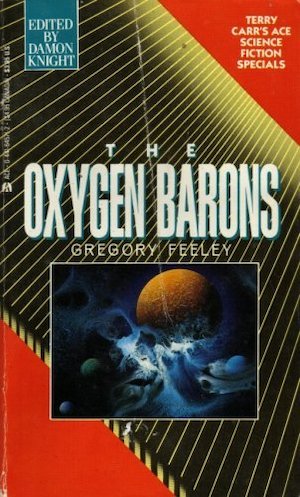
Having very nearly terraformed the Moon, its proud inhabitants declared a Lunar Republic and independence. A less than united independence, as irreconcilable ideological differences between revolutionaries drove a de facto split into two (or perhaps more) Lunar nations. Independence was even more fragile thanks to Earth loyalists (who sustained an interminable civil war) and Earth’s retaliatory embargo of the Moon.
The catch is that the Moon is small and any ecosystem requires constant upkeep. Absent the vast off-moon investments needed to import volatiles and pay for managing the fragile ecosystem, the Moon will revert to a state of nature. That is, lack of nature.
As protagonist Galvanix discovers, the great powers to whom the Lunars might otherwise turn have problems of their own and are largely indifferent to the fate of the Moon. It is possible that declaring independence before the Moon was able to sustain itself was an error.
Red Dust by Paul McAuley (1993)
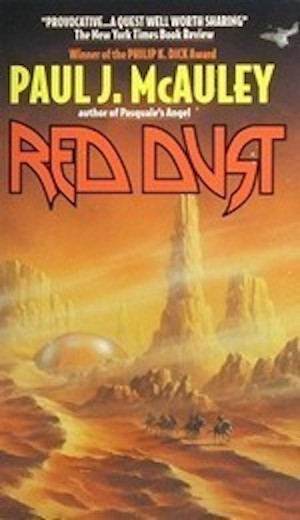
Chinese state policy decreed the terraforming of Mars. A mere six centuries later and the Red Planet is a veritable Barsoom, an arid world on which genetically engineered life abounds. As with Barsoom, keeping Mars life-bearing depends on ongoing effort. Unlike Barsoom, the powers that be are not merely indifferent to the issue of maintenance. They are actively hostile.
Cultists following the Golden Path believe that they must return Mars to its natural state. All life on Mars will end. Being one of the living entities on Mars, this would be highly inconvenient for Wei Lee. Wei Lee is no John Carter of Mars. Nevertheless, circumstances will force him into a heroic role.4
Re-Entry by Paul Preuss (1981)
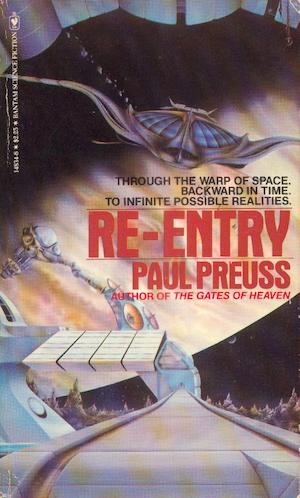
Once lifeless, the planet Bounty was transformed almost overnight into a garden world. A better term might be “bread basket.” Bounty’s crops fed billions back on Earth. Bounty’s new ecosystem proved fatally fragile. The famines that followed the chaotic collapse killed a billion people. The new world order that arose in the aftermath takes a very conservative approach to planetary management.
Not that that directly concerns Philip Holder. Holder is obsessed with an implication of faster-than-light travel: the right path through superspace leads not just to another star but back in time. Armed with that knowledge, Holder sets out to correct history he deems horribly wrong, pursued by a government agent determined to protect the status quo at all costs.5
The Depths of Time by Roger MacBride Allen (2000)
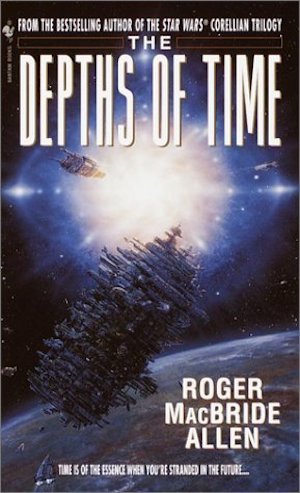
Three technologies have allowed humans to spread across the galaxy. Wormholes through space-time lead across light-years and into the past. Cold-sleep allows travelers to sleep away temporal displacement until they resynchronize with the present. Terraforming turns dead worlds into garden planets. The only limit to terraforming: the number of barren worlds suitable for terraforming. Or so it seems.
In practice, terraforming is difficult. It is more apt to go horribly wrong than to go right. The world Solace is one of those “it didn’t work” cases. At first it seems like a success story. But Admiral Koffield knows the world is actually on the path towards disaster. As was the custom back in 2000, the author crafts a cliff-hanger ending of trilogy-justifying extent.
***
Failed terraforming seems like a development friendly to plots. After all, nothing inspires characters to get off their comfortable recliners like impending death. However, further examples of this very specific subgenre do not readily come to mind. If readers can think of works I’ve overlooked, comments are, as ever, below.
In the words of fanfiction author Musty181, four-time Hugo finalist, prolific book reviewer, and perennial Darwin Award nominee James Davis Nicoll “looks like a default mii with glasses.” His work has appeared in Interzone, Publishers Weekly and Romantic Times as well as on his own websites, James Nicoll Reviews (where he is assisted by editor Karen Lofstrom and web person Adrienne L. Travis) and the 2021 and 2022 Aurora Award finalist Young People Read Old SFF (where he is assisted by web person Adrienne L. Travis). His Patreon can be found here.
[1]For some reason, the books that come to mind in which terraforming is difficult and time consuming were written by women (Bujold, Cherryh, and McIntyre). I don’t know whether that’s an actual pattern or a flaw in my memory. If it is a pattern, I don’t understand it. What possible prior activities would incline men to prefer instant gratification and women to prefer lengthy focus and diligence?
[2]Speaking of edge-cases, George O. Smith’s 1942 “QRM — Interplanetary” is one. Set in a vast space station, the plot is driven by that fact that it is all too easy for one obstructive MBA to inadvertently destroy the infrastructure on which life depends. Only a cad would ruin the moral of the story by calculating how much breathable air a structure the size of Venus Equilateral would contain and how long it would take for the staff to consume it all.
[3]Readers who think “A Princess of Mars” is not so much an edge case as an example of something else entirely may pretend that I instead mentioned two planets featured in “The Mote in God’s Eye,” New Scotland and New Ireland. These two terraformed worlds (populated entirely by ethnic stereotypes) did not deal well with the collapse of civilization some centuries past. This is mentioned only in passing, and isn’t really that relevant to the plot.
[4]Wei Lee is heroic to the extent that any McAuley character can be described as “heroic.” Which is to say, not very.
[5]One fact rather undermines the urgency of the plot: an unavoidable side-effect of superluminal travel is that travelers are shunted into a similar but different universe. Holder’s plan in no way threatens the history of a version of Earth to which he will never return.










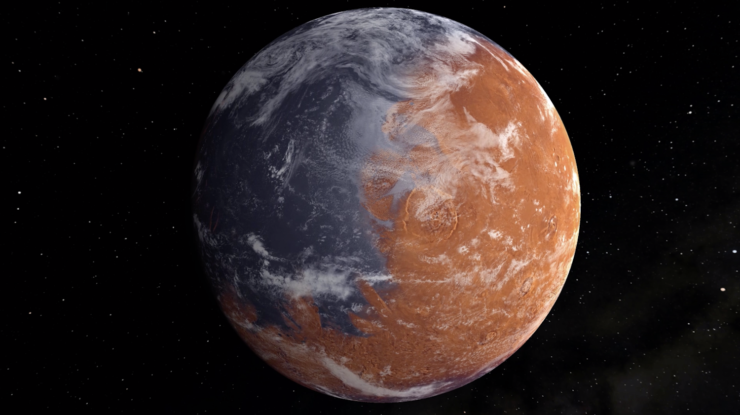
I nearly choked on my coffee after reading your footnote #1.
Allen also wrote the “Isaac Asimov’s Caliban” trilogy, in which the Spacer world on which it’s set was terraformed on the cheap, and some of the inhabitants are beginning to realise just how bad things could get if prompt (and risky) action isn’t taken. They are, of course, outnumbered by the inhabitants who don’t believe there’s anything seriously the matter.
I’m curious about footnote 2, on Venus Equilateral. Is it astonishingly large, as in “Mosey! Mosey for your lives!”? Or astonishingly short, as in you’ll have only a few hours or days, long before the new ___ ______ can get going? (I have only a dim memory of the story, I’m afraid.)
Oh come on, we’re … two? … comments in and nobody has yet mentioned Larry Niven’s A World Out of Time! A hard SF novel from 1977 for some value of “hard” such that pretty much every tool it posits (from cold sleep to Bussard ramjets to using algae to seed the clouds of Venus-type runaway greenhouse worlds) has been consigned to the attic of “why did anyone ever think this was plausible?” before we get to the more typical Niven tropes like tasps and teleport booths and, er, the highly dubious 1970s gender relations (putting the “hard” into “hard SF”: readers of a delicate disposition should aert their eyes now).
An honourable mention is also due to Wil McCarthy’s Queendom of Sol novels, notably The Collapsium, in which the problem of the Lunar gravity well leaking atmosphere (in The Oxygen Barons) is solved through the not-alarming-at-all technique of turning a chunk of the moon’s mass into captive black holes, thereby shrinking it into something with roughly one terrestrial gee at mean surface level: a technology with which absolutely nothing can possibly go wrong. (McCarthy’s watch word ought to be “yes, but what are the failure modes, and how can they best be used to destroy the entire solar system, not just the moon we’re terraforming?”)
I thought Building Harlequin’s Moon was a pretty decent book.
3: There’s enough air in VE to keep the crew alive for years and years. Which given the existence of MBAs who will have the life support system tossed out the airlock in the name of efficiency is a good thing, but it does undermine the urgency of the plot.
For some reason, the books that come to mind in which terraforming is difficult and time consuming were written by women (Bujold, Cherryh, and McIntyre). I don’t know whether that’s an actual pattern or a flaw in my memory.
It’s a flaw in your memory.
Books about difficult, time-consuming and/or ultimately failed terraforming, written by men:
the Revelation Space series by Alastair Reynolds (terraforming Mars is a huge societal effort that requires fanatic devotion and will take thousands of years, it ultimately fails)
the Expanse series by George S.A. Corey (terraforming Mars is a huge societal effort that requires fanatic devotion and will take thousands of years, eventually the Martians give up)
Children of Time by Adrian Tchaikovsky (terraforming goes terribly wrong)
The Space Merchants by Frederik Pohl and CM Kornbluth (terraforming Venus is so hard that you have to deceive people into doing it)
The Sands of Mars by Arthur C Clarke (terraforming Mars will take thousands of years)
Dune by Frank Herbert (terraforming Arrakis is a huge societal effort that requires fanatic devotion and will take thousands of years. Eventually the natives give up)
The War of the Worlds by HG Wells (areoforming Earth is a huge societal effort that requires immense amounts of combat against the puny humans. Eventually the Martians all die)
Cherryh provides an example of a subtly different theme: much of Cyteen’s native plant life can be described as “cottonwood but poisonous and carcinogenic”, and it requires significant infrastructure to produce areas where a person can go outside and not die (possibly decades in the future), and early colonists began terraforming procedures – which were halted sharply when native life that could be processed into anagathics was discovered. And now there is great concern over the dead zone in the sea downstream of the big city’s sewage treatment plant…
@@@@@ Footnote 1: The Expanse (in which the terraforming of Mars is presented as something that will take centuries and no one currently living will ever get to see the results) was written under the pen name James S.A.Corey by Daniel Abraham and Ty Franck. the problem could also be insufficient depth in reading on the subject.
4: As I recall, the Moon was the one settled world in the Solar System McCarthy’s characters didn’t manage to destroy. Yet.
7+ We’ll put it down to “a flaw in my memory.”
The setting of Rosemary Kierstein’s The Steerswoman and sequels is a planet that’s at least incompletely terraformed.
in one of Brian Stableford’s “Daedalus Mission” books – I think it’s the sixth one, The Paradox of the Sets, but couldn’t swear to it without a re-read – sereis protagonist Alexis Alexander looks at the comparative distribution of two different DNA-analogues across the surface of a planet, and concludes that one of them spread outwards from a single point of origin, suggesting that this is a failed terraforming (or, rather, extraterraforming) project by Someone Else.
Marko Kloos’s amiable milSF series “Frontlines” involves a number of worlds in the process of terraforming – mostly, they are economically marginal operations and very unpleasant places to live, and the situation only gets worse when an aggressive and technologically superior nonhuman species shows up, with the demonstrated intention of making these worlds habitable by them instead.
Re #1, adding Kirstein to the list of females who have terraforming as slow and, umm, difficult.
I was wracking my brain for a Poul Anderson failed terraforming story, because it seems like the sort of idea that would appeal to him. No luck, although no doubt I will think of something at 3 AM.
That said, 12 reminds me of Fire Time, where researchers are drawn to an alien world because it has two radically different biochemistries conveniently next to each other. Usually one or another biochemistry wins out, and the resulting ecosystems all share it. Ishtar is different because a billion years earlier, aliens from a doomed world in the same multiple star system carried out a partially successful terraforming project on Ishtar.
Ah! Thought of a borderline deterraforming work by a woman. In MK Wren’s Phoenix Legacy, setting airless moons is as easy as delivering a force field generator, turning it on, filling the volume with air and shipping in the proles to labour away enriching their betters. The catch is that in the event of power failures, the force field vanishes like a burst bubble. It’s very apparent the rulers don’t believe in in-depth redundancy for life support.
Heinlein’s Farmer in the Sky has a near miss with actively maintained terraforming failure when Ganymede’s heat shield goes down.
An outstanding novella about problems with terraforming is Geoffrey A. Landis’ “Ecopoiesis”, in which terraforming Mars doesn’t end up going in the “terra” direction so much.
As I recall, one or two of Kim Stanley Robinson’s extra stories collected in The Martians involves the terraforming failing.
Both Robinson in the Mars books, and Annalee Newitz in her brand new (and quite enjoyable) The Terraformers solve the question of “How to terraform a world in a human lifetime” not by extra quick terraforming, but by greatly extended human lifespans.
Not terraforming as such, but…in James P. Hogan’s Giants series, the ancient aliens tried to change the fusion process of a distant star, and screwed it up so badly the star went nova.
RAISE.
17: I should get around to stellar engineering one of these days.
In Bob Shaw’s The Palace of Eternity, humans deliberately trigger supernova to facilitate the use of Bussard ramjets. The hostile aliens with whom humans share the galaxy pointedly don’t use ramjets despite the military disadvantage this causes for the aliens but it doesn’t occur to the humans to wonder why.
(how do people embed images here?)
@15: Greg Benford wrote Against Infinity partly as a response to Farmer in the Sky. Terraforming Ganymede has been going for one or two generations and isn’t done yet. Humans have introduced a half dozen brand new life forms that are supposed to make the atmosphere breathable, and they mutate at a slow rate, requiring humans to go out and hunt and kill the muties for a per-corpse bounty. Humans have also placed some sort of giant shield around the whole moon to allow the new atmosphere to warm up, which goes wrong in the last third of the book, when [rot13] gur tebjvat urng pnhfrf gur vpr cyngrf sbezvat Tnalzrqr’f pehfg gb senpgher.
Given Ganymede’s composition, I don’t know how the end result isn’t an ocean world.
@18: To imbed an image, I just use the image button at the far right end of the toolbar. Example:
Imgur makes it extremely easy — I just hit the “new post” button, paste the image from the clipboard, then grab a link. Open the link in a new tab, right-click the image and use “open in new tab”, and get the direct URL of the image from the address bar. (It will begin with i.imgur.com and end with .png) Then come back here, use the image icon on the toolbar, and insert the URL in source.
This is weird. I don’t get the full toolbar but a truncated version. I wonder if it is browser dependent?
(checks)
It _is_ browser dependent. Well, that’s useful information.
@22: on my browser, I have to tap twice on a toolbar icon for it to take effect. (The interface here is actively hostile to my device.)
There’s some discussion of failed terraforming in the Murderbot series, in the context of corporations cutting their losses including abandoning colonists. The Preservation group colonized their current world after a previous world was de-terraforming and the inhabitants were luckily rescued. In Network Effect, there have been several waves of colonists on a world that should never have been colonized in the first place.
There is, I suppose, a distinction between failed terraforming as in “nobody can live here, period” and economic failure, as in “it’s liveable but not profitable.”
S.M. Stirling’s pair of planetary romances, The Sky People and In the Court of the Crimson Kings, set real-world politics against a backdrop of a solar system that was extensively fiddled with by sufficiently advanced aliens in the deep past. Part of this experiment(?) (Art project? Attempt to expand the foothold of life?) involved terraforming Mars. The Martian humans are part of the terraforming maintenance mechanism of their planet, but although they are very alien in some ways, they are human to the extent of also being political animals. The sufficiently advanced aliens did not plan for this. Problems have ensued.
When I saw this article, I wondered if Kim Stanly Robinson’s 2015 “Aurora” would make the list.
A favorite of mine, one could argue that Aurora is a “failure of multiple adventures in artificial biology”, and doesn’t qualify as about failed terraforming, because as I recall, its terraforming efforts were abandoned before they even started, and their main worry was maintaining a survivable biosystem in their fast (0.1 c) starship. However you categorize it, I recommend it for fans of hard SF with tempered optimism.
How about the Children of the Star trilogy by Sylvia Loise Engdahl? This Star Shall Abide, Beyond the Tomorrow Mountains, and The Doors of the Universe. It’s a terraforming-not-succeeding when viewed as an ongoing long-term disaster.
#15 – thinking of Farmer in the Sky as well; in RAH’s defense, at the time he wrote it (1949-50), no real evidence on whether Ganymede was rocky, icy, or something else entirely.
Another “old” story that comes to mind is Piper’s Four Day Planet, (also, more or less a juvenile) set on a world colonized by humanity that is home to such extreme orbital mechanics that not only is terraforming pretty much impossible, most of the surviving colonists are evacuated after heavy casualties and the remaining population is reduced to one underground settlement that depends on extracting a single resource that pays for what remains of the colony’s needs and absent which the whole settlement would collapse. This, not surprisingly, leads to conflict.
ISTR that there was a throw-away line in “The Death of Captain Future” about an attempt to terraform Mars that failed with a thud because Mars’s existing environment was rather more complex than the terraformers anticipated.
There is one story (darned and patched if I can recall title and author!) about an organisation working on terraforming planets all over the place. At one planet they permit one very junior member to handle a big part of the tasks. The ecosystem seems to thrive very well, and they leave the system for other terraforming projects.
After some years (20? 30?) they return to check up on the result. Lo and behold. The entire planet is a gigantic ball of icky goo.
The expedition leader tells the junior member that now you see why it is so important to do everything absolutely right in this business.
Monica Hughes has a YA take on failed terraforming with a slightly different angle with her Isis trilogy (Keeper of the Isis Light, The Guardian of Isis, The Isis Pedlar). The first one especially explored the question of humans adapting themselves to a different climate: terran-forming rather than terraforming. Taken through the trilogy overall the question seemed more about the psychological process of overcoming superficial social differences and community cohesion (though no less powerful for all that) rather than strictly the biological process of adaptation, but the first one in particular looked at how the humans might adapt their biology, to what purpose and how other humans might react. As I recall, it was quite simple but quite powerful.
I wonder how to count Hal Clement’s “The Nitrogen Fix” – where accidental anti-terraforming has occurred.
More on point is Niven’s “Protector” in which Earth is rather easily converted to a form that human’s ancestors can live in – but it turns out that there are hidden defects in Earth that doom humanity to a life without endless war.
@31: James Blish coined the word ‘pantropy’ for that, though it never took off the way ‘terraforming’ did.
@32: I don’t recall the Pak doing any environmental engineering on Earth, unless it was in the retcon novels from the Noughties and I garbage collected the brain cell that remembered it.
31: Terran-forming is a different notion, and The Seedling Stars by James Blish should take pride of place.
Alison Sinclair’s Blueheart was about terraforming a water-world that had already been colonized by humans modified to live in an aquatic environment.
I has some trouble understanding how you’d terraform a water-world. The atmosphere was already breathable, as I recall, and the colonists seemed quite happy with things the way they were.
Not a failure, but an odd take on how to deal with the difficulty of terraforming: Cordwainer Smith’s “When the People Fell.” Venus is barely habitable, but China sends milliions (billions?) of people by inexpensive transport to make it more suitable for cultivation. A huge number die, but they seemingly succeed.
Smith also has some worlds (Shayol and Norstrilia, off the top of my head) where terraforming didn’t exactly fail but went in unexpected directions due to something native to the planet.
@31: Monica Hughes’ The Golden Aquarians also fits. Boy meets telepathic amphibians on a planet being terraformed who warn the boy of impending natural disaster, boy must convince colonists to evacuate in order to not die, etc.
In David Weber’s Honorverse there is the planet Grayson, which is mostly habitable, but has a high proportion of heavy metals which makes farming difficult. They are trying to change it, but they require a large number of orbital farms in order to feed the planet.
Aurora by Kim Stanley Robinson was intriguing. Terraforming was this least of what went wrong, and it went way wrong.
John Barnes’ The Sky So Big and Black has people terraforming Mars by hand. It’s not failing, but does have its problems..
@36 – Smith’s Norstrilians, if you recall, were descendants of the survivors of a failed colonization of another world, rescued and resettled on Old North Australia. That previous world may have been an instance of failed terraforming. We learn very little about it, except that it was a hell that possibly made Shayol look like paradise and toughened the survivors up incredibly. Their sheep getting sick may have seemed like yet one more setback until it turned into the jackpot of all jackpots.
I’m a big fan of SF/F books where the heroes go to the library to find information. Roger MacBride Allen has one of the best library scenes ever in the sequels to The Depths of Time. Worthy of Arthur C. Clarke.
Ken MacLeod’s Corporation Wars trilogy is set in a solar system colonized by a robot probe from Earth, with a long-term terraforming project. It’s very well thought-out. Plus it has all the wonderful characters, complex politics, and plot twists that make MacLeod’s writing so great.
What, no mention yet of David Gerrold’s The War Against the Chtorr series? Alien invaders are working on their-home-planet-forming Earth.
justalurkr @@@@@ 39
I remember many things going wrong in Aurora (some more plausible than others), but I’m pretty sure there wasn’t any terraforming at all.
@7: The Sands of Mars is the first example of Clarke’s peculiar belief that it’s OK to blow up astronomical bodies to terraform worlds – they turn Deimos (I think) into a very small sun that’ll burn for a few hundred years. The problem here is that there is already native life – including an apparently sentient species that the hero discovers during the story – and there doesn’t seem to be a huge amount of work going into making sure that the natives can adapt.
See also the finale of 2010 – Odyssey 2 in which Jupiter is turned into a small sun, again with a life span of a few hundred years, so that life on Europa can be bootstrapped. Some unexpected side effects then ensue, proving once and all that the all-seeing all-knowing monolith builders really aren’t quite in the same league as e.g. the Arisians in their planning.
Re Venus – I think that a lot of authors have trouble with the idea of specific heat capacity. Especially that of 4.8675×1024 kg of rock where the MINIMUM temperature is well above the boiling point of lead.
@46 – Sorry, the mass came out, I meant 4.8675×10 to the power 24 kg
There is also John Wyndham (John Benyon Harris). In his “The Kraken Wakes” (“Out of the Deeps” in America), Aliens land in the deepest parts of the oceans, and start melting the Polar Ice-Caps to increase the amount of free water available to them (They also drill the equivalent of the Suez Canal deep underwater). Those aliens are finally defeated, by the use of high-intensity sound-waves (more effective underwater). A free copy of “Kraken” is available on the Internet.
There’s also the extremely strange “The President of the United States, Detective” from 1947. The title character is looking at overflight photos of the USSR that show something odd: construction of what look like entire new port cities, far inland. He deduces the obvious reason: the Soviets are planning to melt the Arctic ice cap using atomic power, raising the sea level and flooding the coastal cities of the hated West. Once they have achieved victory in this way, the new sea level will allow their newly-built ports to be used.
He does the logical thing in response:
he nukes Antarctica, melting that icecap too, raising the sea level even further and flooding the new Soviet ports, and as a side effect opening up a lot of newly defrosted land in Antarctica to colonise.
The story was widely praised at the time, and was apparently meant entirely seriously. And, while looking for a copy online, I found that the original thinker who wrote it, one HF Heard (later seen taking mescalin and LSD in the 50s with Aldous Huxley), expanded it into a SF novel, “The Lost Cavern” https://zapatopi.net/blog/?post=201106060875.review_the_lost_cavern
Mildly surprised nobody has yet mentioned Lois McMaster Bujold’s Vorkosigan Saga: when the original wormhole connection to the planet Barrayar collapsed, the terraforming process was only partly complete, with the result that as of the start of the series, even though Barrayar has been back in contact with the rest of the galaxy for a generation or two, there’s still a lot of native vegetation that is poisonously incompatible with Earth biology. And the more recently settled planner Komarr is still in the early days of its own millennium-long terraforming project, to the extent that an incident that damages its solar reflector arrays threatens to severely affect the entire process and is a major plot point of one of the books (titled, unsurprisingly, Komarr).
As a follow-up to #24 by OtterB, I’ll note that the third of the first four Murderbot novellas (Rogue Protocol) takes place on a decommissioned terraforming platform in orbit over a planet where the process failed to the point that it definitely couldn’t be colonized. So the series definitely includes the concept beyond even the profitability definition of success.
ajay @@@@@ 49:
I found that the original thinker who wrote it, one HF Heard (later seen taking mescalin and LSD in the 50s with Aldous Huxley), expanded it into a SF novel …
That’s a genuinely bizarre-sounding story; thanks for that link.
(I’m amused that Heard’s understanding of Earth’s cryosphere was sufficiently limited that the scheme of the evil, Chinese-controlled USSR probably wouldn’t have worked, since melting the Arctic ice cap (or the tundra) wouldn’t change sea levels very much, but the US response totally would.)
eponymous @@@@@ 50
Mildly surprised nobody has yet mentioned Lois McMaster Bujold’s Vorkosigan Saga
You mean, aside from the original post? (It’s alluded to in the first footnote.)
MCA Howarth pelted universe’s space elves live on what a later character said looked like a failed terraform.
She has a wiki. Too
Peter Davey @48: the ice cap melting was just to screw over humanity, I think. The aliens are deep abyss dwellers, and the drowned coastlines aren’t useful to them as living space.
Janet Kagan’s Mirabile has a habitable world, but less-fun mutations of the imported animal life implied to at least partially be caused by the terraforming side-effects.
Judith Moffatt’s Pennterra has a world where a bunch of Quaker settlers who are willing to adapt to the planet and its inhabitants get along great, but when new arrivals who want to build urban sprawl and make sure they can use all their tech and bring in Earth plants and animals try to settle in, the planet rejects them and all their efforts. Anti-terraforming, if you will. Xenoforming?
While we’re at it, Lois McMaster Bujold has several terraforming worlds that are … centuries long endeavors, with what it looks Barrayar as being “mostly” successful, whereas Komarr is still very much a work in progress and Sergyar has gross, flying jellyfish and giant angry goat-crab things. But at least the air is breathable!
Donald Kingsbury’s Courtship Rite is set on a planet, Geta, where there was minimal or no terraforming, and the only Earth life which is viable are the “eight sacred plants” (which include wheat, barley, soybeans, and potatoes), bees, and humans themselves. The “profane” native life is largely toxic to humans. The Getans are not vegetarians, and we’re introduced immediately to the way in which they have solved the problem of incorporating the complete required range of protein into their diet.
Not sure how the Children of Time series from Adrian Tchaikovsky is missing from this list
I’m just happy to see that someone else has read The Depths of Time. It’s one of my absolute favorite book series and I’ve never seen it mentioned in any “best of” lists before.
#54 – that sounds a lot like Joan Slonczewski, Still Forms on Foxfield, where a similar initial Quaker settlement has made a cooperative relationship with the sentient-plant indigenous life. When earth re-establishes contact, things go awry, and the sentient plant-life has some quantum teeth to expel the newcomers, if it comes to that. It doesn’t of course because they find a peaceful solution (Quakers and all).
There are a couple of Slonczewski’s novels that deal with ethical dilemmas around terraforming.
The Making of the Representative for Planet 8, by Doris Lessing, is another failed terraforming project where whatever the Canopus did to make it habitable went horribly awry, putting the whole planet and its inhabitants on a path to an ice-age and extinction. it’s largely inspired by the Scott expedition to the Antarctic, and about transcendence more than science.
Not sure how the Children of Time series from Adrian Tchaikovsky is missing from this list
And I think we should probably mention Lois McMaster Bujold’s books about six or seven more times, to make sure everyone sees it.
Strata, by Pratchett is a pretty good ‘failed terraforming’ book, if you consider the ending and then the implications of it all!
David Drake’s and SM Stirling’s General series has sort of off to the side a terraforming thats failing and is one motavation for the very very brutal war that Raj Whitehall wages.